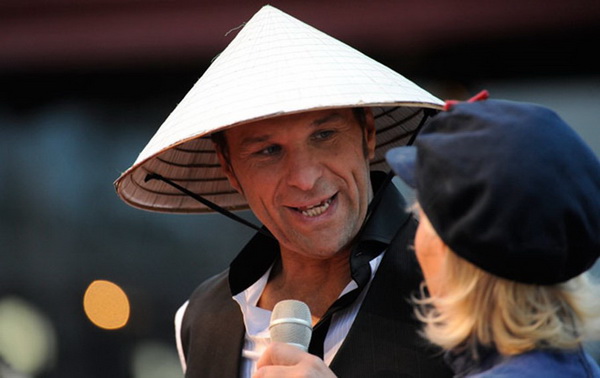Making fun of the Chinese and other East Asians is the last permiisible form of open racism. “Gook humor” is everywhere around us — on stage, in jokes, in film and on our product packaging.

Wherever we go, we encounter the image of a yellow Asian with a coolie hat and grotesquely large front teeth grinning stupidly at us. However, the research indicates that hidden behind our jeering laughter is a form of racism that is similar to the post-WW I-era hatred of Jews.
A while back, journalist Patrik Lundberg, an adoptee from South Korea, penned a column in the Helsingborgs Dagblad about the racism he is subjected to on a daily basis due to his Asian appearance.
“I am used to being humiliated,” Lundberg said.
With people stretching their eyelids to mock him, Patrik Lundberg no longer dares to walk with a camera around his neck, due to the stereotype of the Eager Photographing Asian.
“I’ve dyed my hair and contemplated eye surgery,” wrote Lundberg, whose point was that it wasn’t all about ethnicity per se. “It is about biological racism, based on contempt toward a perceived non-Aryan race.”
However, Lundberg’s column received attention for something entirely different: the author’s criticism of the candy brand, Kinapuffar (China Puffs).
“Everybody thought it was about the candies,” Lundberg now laments. “And the debate was derailed. The problem is that Asian Swedes are usually found among the well-integrated middle-class and it’s thus considered acceptable to kick them around.”
Lundberg will be releasing a book next year, titled, Yellow on the outside, that deals with what it is like to be an Asian in Sweden.
Meanwhile, the research confirms his perception of the prevalent racism against East Asians. It is rooted in a very old notion of East Asians proliferating and threatening to swarm into the world — what is known as the “yellow peril.”
This form of racism began spreading in the 1800s and continued into the 1900s. In the 1970s, it was said that Japan would achieve global domination through its industry — a role currently inherited by China. Financial journalism is replete with articles about “the Chinese” “taking over the world” or “becoming our masters” and this is often illustrated with racist caricatures.
East Asians are perceived as excessively numerous, all looking alike, and diligent, disciplined and well organized.
Unlike racism pertaining to Africans, Asians are regarded as a threat to white supremacy in the Western hemisphere, which is why racist stereotypes about Asians are considered acceptable — they are supposedly rebellious and “kicking at the winners.”
Consequently, these stereotypes resemble another form of racism: the post-WW1 hatred of Jews – the anti-Semitism that preceded the Holocaust.
Exactly as with the Jew-hating humor of the first half of the 1900s, the “Asian” is depicted as threatening and scheming, while simultaneously ugly, geeky and ridiculous.
In particular, the Asian man is depicted as feminine, sycophantic and bears “the closest possible resemblance to anti-Semitic caricatures of Jewish men” today, writes researcher Tobias Hübinette in his report, Japanese, Japanese, Japanese: representations of East Asians in contemporary Swedish visual culture. He points out that East-Asian Swedes are a politically weak and fragmented demographic that has no common lobbying organization, which consequently encumbers their efforts at opposition.
Consequently, racism against Asians continues to be replicated daily in Swedish society.
The host of “Sing-along at Skansen” gets to dress up as a “Chinese” with a coolie hat, while the content of the program portrays the Chinese as “taking over the world.”
As a point of comparison: what if the host were to dress up as an “African” with a curly black wig and shoe polish on his face, or as a Jew with a giant nose, yarmulke and upward palms?
And yet, “gook humor” is regarded as an unfettered protest against scrupulous political correctness. As long as we are afraid of China, Asian Swedes are expected to put up with everyday racism, taunts and “ching-chong” greetings.
Or, to quote Patrick Lundberg: “I want to live in Scandinavia, but about once a week, I just want to die.”





